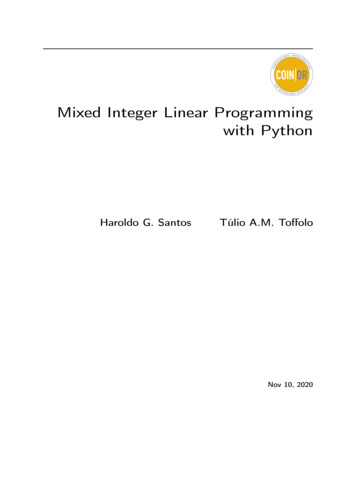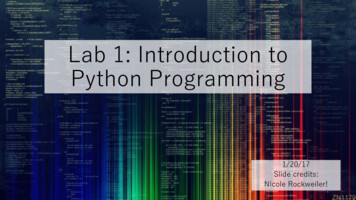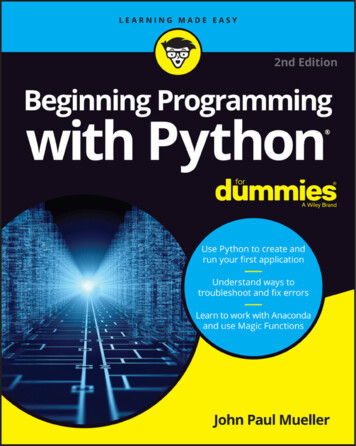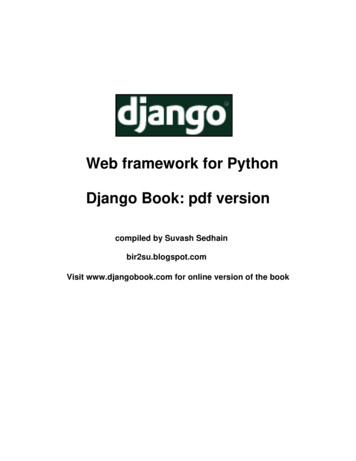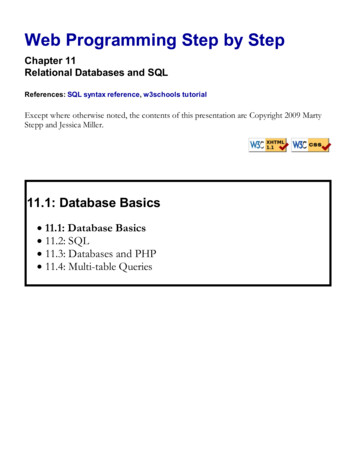
Transcription
Web Programming in Pythonwith Django!Instructors:Steve Levine '11Maria Rodriguez '11Geoffrey Thomas django/Wednesday, January 27thSIPB IAP 2010
Course Overview What is Django? Apps, Models, and Views URL Structure Templates Admin Interface Forms Examples / Tutorials
What is Django?
What is Django?django [jāngō]-noun1.2.3.a shiny web framework that allows one tobuild dynamic, professional-looking websitesin python: Need to make a slick website?Use django!masculine form of popular Hasbro gameJenga (will not be discussed tonight)magic
Funk-tacular Features projects or “apps” are pluggableobject relational mapper: combines the advantagesof having a database with the advantages of usingan object oriented programming languagedatabase allows for efficient data storage andretrievalPython allows for cleaner and more readable code
Funk-tacular Features automatic admin interface offers the functionalityof adding, editing, and deleting items within adatabase in a graphical, user friendly wayflexible template language that provides a way toretrieve data and display it on a webpage in itsdesired formaturl design is elegant and easy to read
Marvelous Websites Made theDjango Way:Models & ViewsApp LayerUser Interface(HTTP Output)ControllerViewMVCModelDatabase LayerMySQL: Database
Marvelous Websites Made theDjango Way:Models & ViewsApp Layer: Outputs HTML (controls how data is displayed to the user)MVC Layer1. Model: Models contains classes definitions for holding data2. View: The View controls the access and filtration of data in order to bepassed onto the app layer for display.3. Controller: The Controller receives and manages inputs to update theModel layer. Additionally, it also updates the elements for the View layeras necessary.Database Layer: The models are stored in database tables in MySQL.
The Django Way
Amazing Apps Django does not work quite like PHP, or otherserver side scripting languages Django organizes your website into apps An app represents one component of a website Example: a simple web poll, blog, etc. Apps can be used in multiple differentwebsites/projects (“pluggable”), and a websitecan have multiple apps
Amazing Apps Each app has its own data and webpages associatedwith it – called models and views, respectivelyExample: a poll that lets users vote on questions Views (different webpages): Page with questions choices (actual voting page) Statistics page that shows past resultsModels (data): Poll questions Choices associated with each question The actual voting data! (set of selected choices)
Amazing Apps When you create an app, Django makes a folder,appname/ in your project directoryIt contains, among some other files: models.py views.py urls.py (will be discussed later)The app looks like a package (ex., polls.view,polls.models, etc.)
Models
Magnificent Models Models store data for your app Key for making dynamic websites! Models are implemented as Python classes, inmodels.py fileAwesome feature of Django: the “object relationalmapper” Allows you to access/change a database (ex.,MySQL) just by calling functions on your models
Magnificent ModelsExample models:from django.db import modelsclass Poll(models.Model):question models.CharField(max length 200)pub date models.DateTimeField('date published')class Choice(models.Model):poll models.ForeignKey(Poll)choice models.CharField(max length 200)votes models.IntegerField()
Magnificent Models Can easily create instances of your model:p Poll(question "What's up?",pub date datetime.datetime.now()) Save it to the database:p.save() The object relational mapper takes care of allthe MySQL for you!
Magnificent Models The object relational mapper even automagicallysets up your MySQL databaseExample generated code:BEGIN;CREATE TABLE "polls poll" ("id" serial NOT NULL PRIMARY KEY,"question" varchar(200) NOT NULL,"pub date" timestamp with time zone NOT NULL);CREATE TABLE "polls choice" ("id" serial NOT NULL PRIMARY KEY,"poll id" integer NOT NULL REFERENCES "polls poll" ("id"),"choice" varchar(200) NOT NULL,"votes" integer NOT NULL);COMMIT;
Magnificent Models Example methods and fields: Poll.objects.all() - returns list of allobjectsp.questionPoll.objects.filter(question startswith 'What')(This function was autogenerated by Django!)
A word about databases Although Django certainly does do a lot for you, ithelps to know a bit about databasesWhen designing a model, useful to think aboutgood database practice
Digestible DatabasesGood Database Design in a Nutshell:1. Groups of related fields belong in the same table2. New tables should be created for data fields that arealmost always empty3. Most of the time the information contained inunrelated fields will not need to be retrieved at thesame time, so those groups of fields should be inseparate fields as one another
Digestible DatabasesExample Database:(a) Patient TablePatientIDLastNameFirstNameRoomNo.(b) Medication TablePrescriptionIDPatient IDMedicationDosageInstruction(c) Schedule TableScheduleIDPrescriptionIDTimeNext AdminDateMTW RFSaSu
Views
Vivacious Views Views are Python functions they make the webpages users see Can make use of models for getting data Can use anything that Python has to offer! .and there's A LOT Python can do! Makes forinteresting websites
Vivacious Views
Vivacious Views View functions take as input: HttpResponse object– contains useful information about the client,sessions, etc.Return as output HttpResponse object – basicallyHTML outputMost often, views don't actually write HTML – theyfill in templates! (discussed shortly)
Vivacious Views Example view:from django.shortcuts import render to responsefrom mysite.polls.models import Polldef index(request):latest poll list Poll.objects.all().order by('-pub date')[:5]return render to response('polls/index.html', {'poll list': poll list})
Templates
Templates, Tags, & TricksThe Django template languageconsists of tags, which performmany functions and may beembedded in a text file to do neattricks.
Templates,Tags,&TricksTags:Ex. variable{{ poll.question }}Ex. for-loop{% for choice in poll.choice set.all %} {% endfor %}Ex. if-statement{% if patient list %}.{% else %}.{% endif %}
Templates, Tags, & TricksExample: Displaying poll results html h1 {{ poll.question }} /h1 ul {% for choice in poll.choice set.all %} li {{ choice.choice }} -- {{ choice.votes }}vote{{ choice.votes pluralize }} /li {% endfor %} /ul /html
Django URL Structure
Utterly Unblemished URL's Django structures your website URL's in aninteresting wayRecap: the URL is the text you type to get to awebsiteFor non Django websites: ers to a file /some/directory/index.php on theserverDifferent in Django! URL's are organized moreelegantly and more easily understandably
Utterly Unblemished URL's Consider this example: http://example.com/articles/2005/03/URL specifies article date, not a reference to aspecific fileAllows a more logical organization, that is lesslikely to change over time
Utterly Unblemished URL's Overview of how Django works, using wsTemplatesURLConfView: polls()Template: plainView: articles()Template: fancyView: authors()Template: cute
Utterly Unblemished URL's URL patterns map to Views Views may use templates Templates contain HTML (discussed later) This puts a layer of abstraction between URLnames and filesThe file urls.py that specifies how URL's getmapped to views, using regular expressions
Utterly Unblemished URL's Example urls.py:urlpatterns patterns('',(r' articles/2003/ ', 'news.views.special case 2003'),(r' articles/(?P year \d{4})/ ', 'news.views.year archive'),(r' articles/(?P year \d{4})/(?P month \d{2})/ ', 'news.views.month archive'),(r' articles/(?P year \d{4})/(?P month \d{2})/(?P day \d )/ ', 'news.views.article detail'),) http://example.com/articles/2009/03/14 will resultin news.views.article detail(request, year '2009',month '03', day '14') being called
Utterly Unblemished URL's These are mostly like regular expressions, whichare outside of the scope of this class
Admin Interface
Awesome Automatic Admin“Generating admin sites for your staff or clients to add, change and delete content istedious work that doesn’t require much creativity. For that reason, Django entirelyautomates creation of admin interfaces for models.Django was written in a newsroom environment, with a very clear separation between“content publishers” and the “public” site. Site managers use the system to addnews stories, events, sports scores, etc., and that content is displayed on the publicsite. Django solves the problem of creating a unified interface for siteadministrators to edit content.The admin isn’t necessarily intended to be used by site visitors; it’s for site managers.”Reference: l02/
l02/
Forms
Fun with FormsWhy use them?1. Automatically generate form widgets.2. Input validation.3. Redisplay a form after invalid input.4. Convert submitted form data to Python data types.
Example:Fun with Forms h1 {{ poll.question }} /h1 {% if error message %} p strong {{ error message }} /strong /p {% endif %} form action "/polls/{{ poll.id }}/vote/" method "post" {% csrf token %}{% for choice in poll.choice set.all %} input type "radio" name "choice" id "choice{{ forloop.counter }}"value "{{ choice.id }}" / labelfor "choice{{ forloop.counter }}" {{ choice.choice }} /label br / {% endfor %} input type "submit" value "Vote" / /form
Fun with Forms
Other Nifty Django Features
Satisfying Sessions You can uses sessions in Django, just like thesessions in PHP Sessions allow you to store state across differentpages of your websiteCommon uses: store logged in username, shoppingcart information, etc.If you write to a session in one view (webpage), itwill be visible in all views afterwards as wellSession is found in the HttpResponse object
Real Live Examples!
Real-World Apps edsched/admin/ /
Tutorial: PollingSetting up Django through Scripts:1. connect to athena: ssh username@linerva.mit.edu2. set up scripts add scripts scripts3. Follow instructions from there to install Django4. connect to scripts: ssh scripts.mit.edu cd /Scripts
Helpful Commands From project folder run mysql type “show databases;” to see your databases type “use database name ;” to use a database type “show tables;” to view the tables in thatdatabasetype “drop table table name ;” to drop a tableDrop affected tables each time fields within yourmodels change.
Helpful Commands ./manage.py syncdbor python manage.py syncdbUpdates database tables whenever you droptables or add applications to INSTALLED APPS insettings.py add scripts for each server pkill u maria pythonRestarts the development server to see your changes.
Handy References Official Django website:http://www.djangoproject.org/ Contains an amazing tutorial that you should follow Information on setting up Django Documentation for various classes, functions, etc.
What is Django? django [jāngō]-noun 1. a shiny web framework that allows one to build dynamic, professional-looking websites in python: Need to make a slick website? Use django! 2. masculine form of popular Hasbro game Jenga (will not be discussed tonight) 3. magicFile Size: 921KBPage Count: 52


![Fluent Python : [clear, concise, and effective programming]](/img/1/799981060.jpg)
